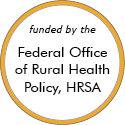Cancer Prevention and Treatment in Rural Areas – Models and Innovations
These stories feature model programs and successful rural projects that can serve as a source of ideas and provide lessons others have learned. Some of the projects or programs may no longer be active. Read about the criteria and evidence-base for programs included.
Evidence-Based Examples
Chronic Disease Self-Management Program
Updated/reviewed November 2025
- Need: To help people with chronic conditions learn how to manage their health.
- Intervention: A small-group 6-week workshop for individuals with chronic conditions to learn skills and strategies to manage their health.
- Results: Participants have better health and quality of life, including reduction in pain, fatigue, and depression.
Project ENABLE (Educate, Nurture, Advise, Before Life Ends)
Updated/reviewed May 2025
- Need: To enhance palliative care access to rural patients with serious illness, such as advanced cancer, heart failure, and COPD, and their family caregivers.
- Intervention: Project ENABLE consists of: 1) an initial in-person palliative care consultation with a specialty-trained provider and 2) a semi-structured series of weekly, phone-delivered, nurse-led or palliative care coach/navigator sessions designed to help patients and their caregivers enhance their problem-solving, symptom management, and coping skills.
- Results: Patients and caregivers report higher quality of life and lower rates of depression and (caregiver) burden.
Promising Examples
The Rural Virtual Infusion Program

Updated/reviewed November 2025
- Need: Allow rural cancer patients in a region inclusive of 26 counties in Iowa, Minnesota, and South Dakota to have access to tertiary-level chemotherapy regimens administered in rural infusion centers.
- Intervention: With telehealth-based oversight from a tertiary care oncology team, 3 rural infusion teams were trained to coordinate cancer treatment plans and administer complex chemotherapy regimens.
- Results: The original grant-supported effort — with its results of saving130 patients 65,000 trip miles and 1,800 travel hours – proved sustainable.
Other Project Examples
Mind Your BEAT
Updated/reviewed January 2026
- Need: Rural cancer survivors report lower levels of physical activity and higher rates of psychosocial distress compared to their urban counterparts.
- Intervention: Researchers collaborated with a rural-serving organization in northeast Texas to test a 3-month intervention which enhanced an existing exercise program with behavioral health education, yoga, and home-based exercise components.
- Results: Program participants were twice as likely to report meeting physical activity recommendations at post-intervention than participants in a control group and reported significant reductions in psychosocial distress.
Garrett County Regional Cancer Patient Navigator Program

Updated/reviewed March 2020
- Need: Comprehensive cancer services for residents of an 8-county, 3-state area in Appalachia.
- Intervention: Using a Cancer Patient Navigation Tool Kit, a Maryland acute care facility led a multidisciplinary collaboration that provided the area's patients with expanded cancer treatment services.
- Results: In addition to several new cancer-related programs, expanded services are now available for cancer patients, families, and cancer survivors.
Last Reviewed: 7/18/2022

